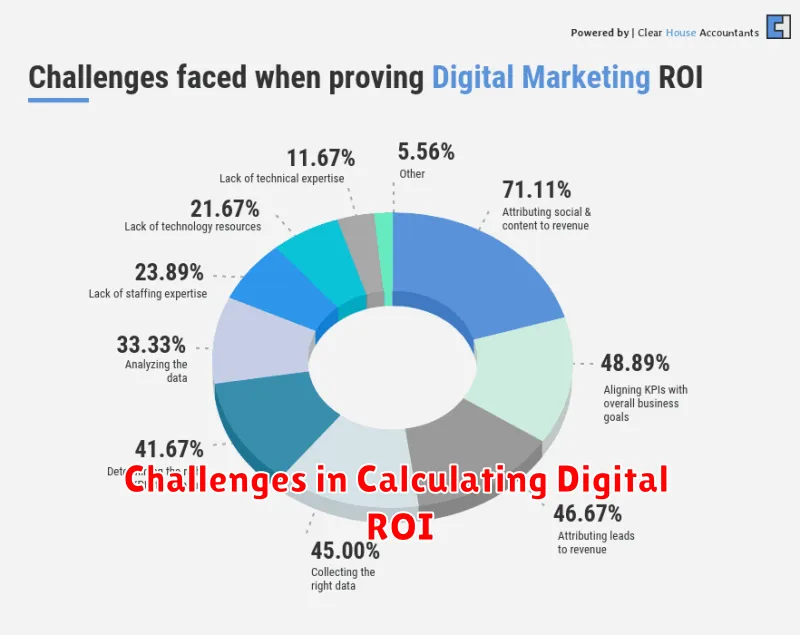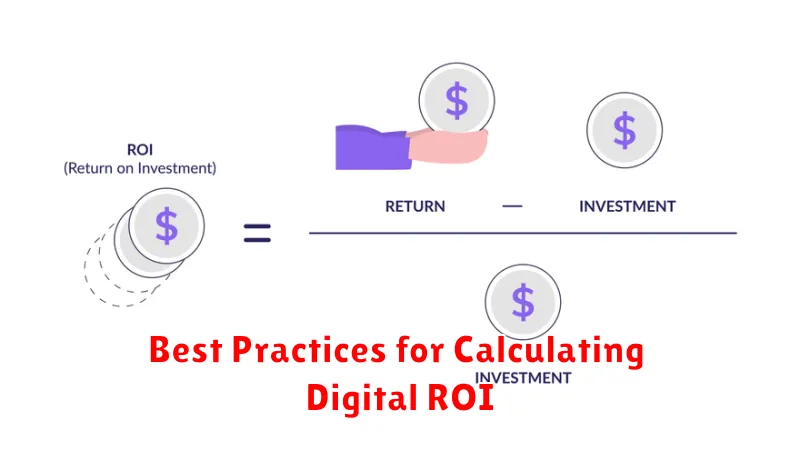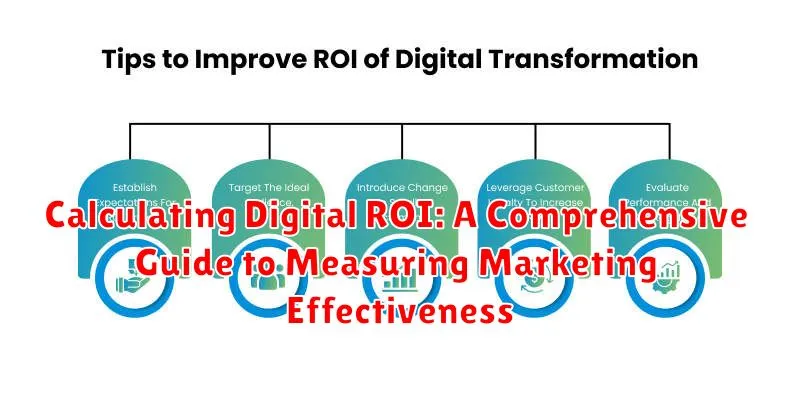In today’s digital landscape, understanding the return on investment (ROI) of your marketing efforts is paramount. Calculating digital ROI allows businesses to measure marketing effectiveness, optimize campaigns, and allocate budget strategically. This comprehensive guide will delve into the intricacies of measuring the impact of your digital marketing activities, providing you with the tools and knowledge to demonstrate the value of your investment and make data-driven decisions.
This guide will cover various methodologies for calculating digital ROI, including attributing revenue to specific channels, understanding key performance indicators (KPIs) like conversion rates and customer lifetime value (CLTV), and leveraging analytics platforms to gain actionable insights. Whether you’re focused on social media marketing, search engine optimization (SEO), pay-per-click (PPC) advertising, or email marketing, this guide will equip you with the framework necessary to effectively measure marketing effectiveness and demonstrate a positive return on your digital marketing spend.
What is Digital ROI?
Digital Return on Investment (ROI) is a key metric used to evaluate the profitability of your digital marketing campaigns. It essentially measures the revenue generated for every dollar spent on digital marketing activities.
Calculating digital ROI helps you understand which marketing efforts are driving the most significant financial returns and which ones need adjustments or to be discontinued. It provides a clear picture of your marketing effectiveness, allowing for data-driven decisions and optimization.
Unlike other marketing metrics that focus on engagement or reach, digital ROI is specifically concerned with the monetary gains. This focus on profitability makes it a crucial metric for businesses of all sizes, from small startups to large corporations.
Why Calculate Digital ROI?
Calculating Digital ROI is crucial for several reasons. It provides tangible insights into the effectiveness of your marketing campaigns, allowing you to understand which strategies are generating the greatest return and which are underperforming.
By understanding your ROI, you can make data-driven decisions about future investments, optimizing your budget allocation for maximum impact. This helps avoid wasteful spending on ineffective channels and allows you to focus resources on the most profitable activities.
Furthermore, calculating ROI enables you to demonstrate the value of your marketing efforts to stakeholders. Presenting clear data on return generated builds confidence and justifies continued investment in digital marketing initiatives.
Finally, measuring ROI fosters a culture of accountability within your marketing team. By tracking and analyzing performance, teams are encouraged to continuously refine their strategies and strive for better results.
Key Metrics for Calculating Digital ROI
Accurately measuring digital ROI relies on selecting the right key performance indicators (KPIs). These metrics provide quantifiable data to assess campaign effectiveness and overall marketing performance.
Some essential metrics include:
- Website Traffic: This encompasses unique visitors, page views, and bounce rate, offering insights into audience engagement and website performance.
- Leads: Track the number of qualified leads generated through various digital channels. This metric directly reflects campaign effectiveness in capturing potential customers.
- Conversions: Measure completed desired actions, such as purchases, form submissions, or sign-ups. Conversions represent the ultimate goal of many marketing campaigns.
- Customer Lifetime Value (CLTV): This metric estimates the total revenue generated by a customer over their relationship with your business. Understanding CLTV helps assess long-term ROI.
- Cost Per Acquisition (CPA): Calculate the cost associated with acquiring a new customer. This crucial metric helps optimize campaign spending and maximize ROI.
By monitoring and analyzing these key metrics, businesses can gain a clearer understanding of their digital marketing performance and make data-driven decisions to improve ROI.
Different Methods for Calculating Digital ROI
Several methods exist for calculating digital ROI, each offering a unique perspective on marketing effectiveness. Choosing the right method depends on the specific campaign goals and the available data.
Simple ROI
This is the most basic method, calculated as (Net Profit – Cost of Investment) / Cost of Investment. It provides a general overview of profitability but lacks the nuance of more sophisticated methods.
Cost Per Acquisition (CPA)
CPA focuses on the cost efficiency of acquiring new customers. It’s calculated by dividing the total marketing campaign cost by the number of new customers acquired. This method is valuable for campaigns focused on lead generation and sales.
Return on Ad Spend (ROAS)
ROAS specifically measures the effectiveness of advertising campaigns. It’s calculated as (Revenue Generated from Advertising / Cost of Advertising) * 100. A higher ROAS indicates a more efficient ad campaign.
Customer Lifetime Value (CLTV)
While not a direct ROI calculation, CLTV is essential for understanding the long-term value of customer acquisitions. By estimating the total revenue a customer will generate over their relationship with a business, you can better assess the long-term ROI of marketing campaigns.
Challenges in Calculating Digital ROI

Accurately measuring digital ROI isn’t without its hurdles. One common challenge is attribution. Determining which marketing efforts directly influenced a conversion can be complex, especially with multi-touch attribution models where various channels play a role.
Another challenge lies in data integration. Consolidating data from various sources, such as CRM systems, analytics platforms, and advertising platforms, can be technically demanding and time-consuming.
External factors, like market fluctuations and competitor activity, can also impact results, making it difficult to isolate the true ROI of marketing campaigns. Furthermore, focusing solely on short-term financial gains can overshadow the long-term benefits of brand building and customer engagement.
Finally, keeping up with the evolving digital landscape and accurately measuring new channels and tactics presents an ongoing challenge for marketers.
Tools and Technologies for Calculating Digital ROI
Several tools and technologies can streamline the process of calculating digital ROI and provide valuable insights into marketing performance. Choosing the right tools depends on the specific needs of your business and the complexity of your campaigns.
Analytics Platforms are fundamental for collecting and analyzing data. Google Analytics is a widely used free platform offering comprehensive data on website traffic, user behavior, and conversions. Adobe Analytics provides more advanced features for enterprise-level analysis and customization.
Marketing Automation Platforms like HubSpot and Marketo can track leads, automate marketing activities, and measure the ROI of individual campaigns. These platforms often integrate with CRM systems to provide a holistic view of customer interactions.
CRM (Customer Relationship Management) Systems such as Salesforce are valuable for tracking customer interactions across different channels and attributing revenue to specific marketing efforts. This helps connect marketing activities directly to sales outcomes.
Attribution Modeling Tools assist in determining how much credit each marketing touchpoint deserves for a conversion. These tools use algorithms to analyze complex customer journeys and provide a more accurate view of campaign performance.
Spreadsheet Software such as Microsoft Excel or Google Sheets can be used for basic calculations and data visualization. While not as powerful as dedicated platforms, they can be useful for smaller businesses or for creating custom reports.
Best Practices for Calculating Digital ROI

Accurately calculating digital ROI requires adherence to certain best practices. Establish clear objectives from the outset. Define what you want to achieve with your digital marketing efforts, whether it’s lead generation, sales, or brand awareness. This provides a benchmark against which to measure success.
Track all relevant metrics consistently. This might include website traffic, conversion rates, cost per click (CPC), and customer lifetime value (CLTV). Use a consistent tracking methodology across all campaigns.
Isolate campaign variables where possible. A/B testing different versions of ads or landing pages helps determine which elements contribute most to ROI. This allows for optimization and resource allocation toward the most effective strategies.
Regularly review and refine your approach. Digital marketing is dynamic. Continuously analyze your ROI data and adjust your strategies based on performance. This iterative process is crucial for maximizing returns.
Interpreting and Utilizing Digital ROI Data
Once you’ve calculated your digital ROI, the next crucial step is interpreting the data and using it to optimize your marketing strategies. A positive ROI indicates that your campaigns are generating more value than their cost, while a negative ROI signals the need for adjustments.
Benchmarking your ROI against industry averages or your past performance provides valuable context. This helps determine if your results are strong or require improvement. Analyzing ROI data across different campaigns or channels can reveal top performers and areas for optimization.
Use your findings to inform future marketing decisions. High-performing campaigns can be scaled up, while underperforming ones should be reevaluated or discontinued. Don’t solely focus on the overall ROI. Dive deeper into individual metrics to understand what drives success. For example, a high conversion rate combined with a low average order value may suggest opportunities to increase customer spending.

